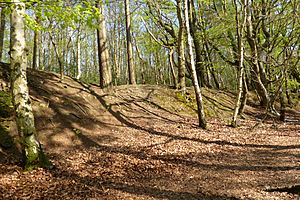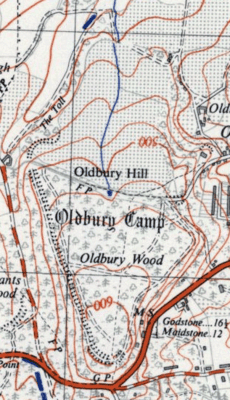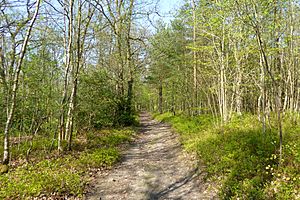Oldbury Camp facts for kids
Oldbury Camp, also called Oldbury hill fort, is the biggest Iron Age hill fort in south-eastern England. It was built a long time ago, around 100 BC. Celtic British tribes built it on a hill near Ightham, Kent. This spot was very smart because it looked over important paths through the Kentish Weald.
The fort has a big bank and a ditch around it. It covers about 50 hectares (that's like 120 football fields!). There were entrances at the north-east and south ends, with strong wooden gates. People have dug up parts of the fort in the 1930s and 1980s. They found that people probably didn't live there all the time. The fort was left empty around 50 BC. The north-east gate was even burned down. This might have happened because of a Roman invasion. Today, the southern, wooded part of Oldbury Camp belongs to the National Trust. You can visit it and explore!
Contents
What is Oldbury Camp?
Oldbury Camp is found close to the village of Ightham in Kent. It sits on top of Oldbury Hill. This hill is a wooded area that runs north to south along the Greensand Ridge. On its eastern side, the hill has very steep natural cliffs. From here, you can see far across one of the main routes through the Weald.
The hill fort covers about 50 hectares. It is a "multivallate" type of fort. This means it has more than one line of defense in some places. Most of the fort has a single bank and ditch around the north, west, and south sides. But in a few spots, the bank is doubled for extra protection. The bank was probably about 10 meters tall when it was new. Now, it's only about 1 meter high. The ditch is up to 3.5 meters wide and about 3 meters below the top of the bank.
There were at least two entrances to the fort. One was on the north-east side and the other on the south. A natural spring is near the middle of the site. This would have given the fort's defenders fresh water all the time. There are also caves and hollows in the rocks on the eastern side. These places, called the Oldbury rock shelters, were used by people as far back as the Middle Paleolithic period.
When Was Oldbury Camp Built?
The hill fort was built during the first century BC. It was likely a huge project that was finished very quickly. Around 100 BC, workers first dug a V-shaped ditch. This ditch was about 1.5 meters deep and formed the outer edge of Oldbury Camp. The dirt from the ditch was piled up to make the bank. The defenses form a rough diamond shape. They measure 1350 meters from north to south and 700 meters from east to west. The eastern side, above the cliffs, probably only had a wooden palisade. The steep cliffs there meant a bank and ditch weren't needed.
Later, the defenses were made even stronger. More material was added to the bank to make a sloping surface called a glacis. The ditch was also made wider and flatter at the bottom. This style is called "Fécamp" after a similar fort in France. At the north-east entrance, a stone wall, called a revetment, was built. It probably had a wooden fence above it. This protected a heavy wooden gate, which also had an extra defensive wall in front of it. This gate was later destroyed by fire. Many sling stones were found nearby. Another gate was at the south entrance, but a modern road has damaged it.
It's not clear if there were buildings inside the fort. However, many pieces of pottery have been found there. Oldbury Camp was probably used as a temporary shelter or a safe place to hide. It was likely not a place where people lived all the time.
We don't know for sure why Oldbury Camp was built or why it was left empty. It might have been built by a local tribe trying to stop an invasion. This was around the time of the Belgae. They were a group of tribes from northern Gaul. But the Belgae were successful and took over Kent. The fort was abandoned around the time of Caesar's invasions of Britain in 55 and 54 BC. The Romans might have attacked it, which could explain the burned northern gate. Or, the defenders might have burned it themselves as they left. Parts of the site seem to have been used for digging out stone during the Roman period.
Exploring Oldbury Camp: What Did We Find?
Oldbury Camp has been dug up by archaeologists twice. The first time was in 1938 by John Bryan Ward-Perkins. The second time was in 1983–84. The 1938 digs first thought the fort was built in two stages, about 50 years apart. But the later digs in 1983–84 showed this was wrong. They found it was built all at once, very quickly. People also used to think that the Belgae had made the defenses stronger to fight off the Roman invasion. But now, this seems unlikely.
Visiting Oldbury Camp
The southern part of Oldbury Hill and Styants Wood next to it are now owned by the National Trust. They bought it in 1945, and it is open for everyone to visit. Kent County Council helps manage the area. The northern part of the fort is private farmland. However, it is protected so it won't be built on.





